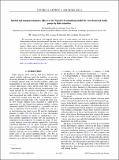Spatial and temporal memory effects in the Nagel-Schreckenberg model for crowdsourced traffic property determination
Author(s)
Botshekan, Meshkat; Ulm, Franz-Josef
DownloadPublished version (7.774Mb)
Publisher Policy
Publisher Policy
Article is made available in accordance with the publisher's policy and may be subject to US copyright law. Please refer to the publisher's site for terms of use.
Terms of use
Metadata
Show full item recordAbstract
We investigate the spatial and temporal memory effects of traffic density and velocity in the Nagel-Schreckenberg cellular automaton model. We show that the two-point correlation function of vehicle occupancy provides access to spatial memory effects, such as headway, and the velocity autocovariance function to temporal memory effects such as traffic relaxation time and traffic compressibility. We develop stochasticity-density plots that permit determination of traffic density and stochasticity from the isotherms of first- and second-order velocity statistics of a randomly selected vehicle. Specifically, provided ergodicity and stationarity, these stochasticity-density plots permit a direct determination of traffic properties from crowdsourced measurements of velocities of vehicles. We illustrate the predictive prowess of the approach for crowdsourced vehicle speed data collected by anonymous smartphone measurements for the state of Massachusetts, USA, as a powerful alternative to classical traffic property estimates from spatially distributed user counts.
Date issued
2021Department
Massachusetts Institute of Technology. Department of Civil and Environmental EngineeringJournal
Physical Review E
Publisher
American Physical Society (APS)
Citation
Botshekan, Meshkat and Ulm, Franz-Josef. 2021. "Spatial and temporal memory effects in the Nagel-Schreckenberg model for crowdsourced traffic property determination." Physical Review E, 104 (4).
Version: Final published version